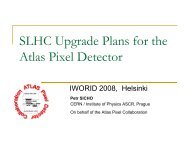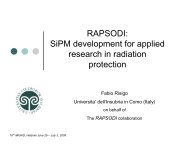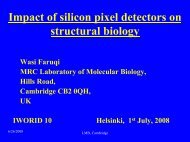Active Macro Pixel Sensor Array - Helsinki Institute of Physics
Active Macro Pixel Sensor Array - Helsinki Institute of Physics
Active Macro Pixel Sensor Array - Helsinki Institute of Physics
Create successful ePaper yourself
Turn your PDF publications into a flip-book with our unique Google optimized e-Paper software.
Progress with<br />
<strong>Active</strong> <strong>Macro</strong> <strong>Pixel</strong> <strong>Sensor</strong> <strong>Array</strong>s<br />
for X-ray X<br />
Imaging Spectroscopy<br />
Heike Soltau, P. Lechner, L. Strüder et al<br />
PN<strong>Sensor</strong> GmbH Munich<br />
MPI Semiconductor Laboratory Munich<br />
IWORID 2008, <strong>Helsinki</strong>
Spectrometric Parameters<br />
• energy range<br />
100 eV to 20 keV<br />
<strong>Active</strong> <strong>Macro</strong> <strong>Pixel</strong> <strong>Sensor</strong> <strong>Array</strong>s<br />
are attractive • high quantum efficiency<br />
with thin entrance window<br />
because they allow<br />
and depleted volume <strong>of</strong> 450 µm<br />
–• monolithic minimum devices signal capacitance<br />
in large formats up to 8 x 8 cm²<br />
<strong>of</strong> 20 fF only<br />
– with scalable pixel size<br />
• energy e.g. 300 resolution x 300 µm² down to to 1 x 1 mm²<br />
– charge 50 storage eV @ C capability K<br />
in contrast to a CCD<br />
125 eV @ Mn K<br />
–<br />
•<br />
line<br />
image<br />
readout<br />
(frame)<br />
on demand<br />
rates<br />
with a limited complexity<br />
up to 8.000 per sec<br />
and a high speed<br />
• low electronic noise at high rates<br />
10 el. ENC<br />
• radiation hardness<br />
<strong>Active</strong> <strong>Macro</strong> <strong>Pixel</strong> <strong>Sensor</strong> <strong>Array</strong>s
<strong>Active</strong> <strong>Pixel</strong> with DEPMOSFET Amplifier<br />
The pixel is<br />
made up by<br />
• topology<br />
• internal<br />
amplification<br />
• charge storing<br />
capability<br />
• integrated<br />
reset FET<br />
Operation Mode<br />
fully depleted<br />
volume <strong>of</strong> Si<br />
usually OFF<br />
p+ back FET ON contact<br />
and internal drift rings gate<br />
internal Measure gate exists I ds<br />
Clear in ON Internal and OFF Gate<br />
deep state Measure MOSFET n-implantation<br />
<strong>of</strong> the IFET<br />
ds<br />
p-channel ⇓ on<br />
n-type low power<br />
current bulk<br />
local change potential prop.<br />
consumption<br />
to number minimum with <strong>of</strong> electrons<br />
internal for electrons gate<br />
and clear gate<br />
DI > 300 pA / electron
From <strong>Active</strong> <strong>Pixel</strong> <strong>Sensor</strong>s (APS)<br />
to <strong>Active</strong> <strong>Macro</strong> <strong>Pixel</strong> Detectors<br />
<strong>Macro</strong> <strong>Pixel</strong> Detector which is mainly<br />
a DEPFET surrounded by Drift Rings<br />
allows<br />
9 monolithic assembly <strong>of</strong> large areas<br />
9 with minimum number <strong>of</strong> pixels<br />
<strong>of</strong> individually addressable pixels<br />
in arbitrary size<br />
9 homogenous backside<br />
with a fill factor <strong>of</strong> 1<br />
keeping the good properties <strong>of</strong> the APS<br />
9 low noise<br />
9 low power consumption<br />
9 fast processing etc.
<strong>Active</strong> <strong>Macro</strong> <strong>Pixel</strong> <strong>Sensor</strong> <strong>Array</strong><br />
readout sequence<br />
matrix operation<br />
• 1st measurement: signal + baseline<br />
• clear: removal <strong>of</strong> signal charges<br />
• 2nd measurement: baseline<br />
• difference = signal<br />
• complete clear is mandatory<br />
• horizontal supply lines, row selection<br />
• vertical signal lines<br />
• 1 active row, other pixels integrating<br />
option to speed up (1)<br />
• readout parallelisation<br />
• 2 x readout channels, 2 active rows
<strong>Active</strong> <strong>Macro</strong> <strong>Pixel</strong> <strong>Sensor</strong> <strong>Array</strong> –Read Out<br />
CAMEX64 readout chip<br />
• 64 channel amplifier<br />
• source follower configuration<br />
• 8-fold CDS filter<br />
• 64/1 analog multiplexer<br />
• readout time / row 4 µsec<br />
option to speed up (2)<br />
2 x SWITCHER-II control ASIC<br />
• 64 channel control chip<br />
• 2 ports / channel<br />
• supply <strong>of</strong> switched voltages<br />
• extremely low noise level<br />
• high voltage CMOS process > 20 V p-p<br />
• 50 MHz clock<br />
• "VELA" readout chip by Politecnico di Milano<br />
drain current readout<br />
current (de)integration filter<br />
readout time / row = 2 µsec
Application I<br />
Low Energy Detector (LED) for Simbol-X Mission<br />
Joint French-Italian project<br />
German participation: - mirror calibration<br />
- Low Energy Detector<br />
1 st focussing hard X-ray telescope<br />
ranging between 0.5 keV .. 20 keV .. 80 keV<br />
science targets<br />
• census and physics <strong>of</strong> black holes<br />
• cosmic particle acceleration<br />
mission scenario<br />
• launch mid 2014 (Soyuz-Fregat/Kourou)<br />
• autonomous formation flight<br />
• life time 3 y (+ 2y)<br />
• pointings 1000 (+ 500)<br />
• science time<br />
instrumentation<br />
• low energy detector LED<br />
> 100 Msec<br />
• high energy detector HED
Application I<br />
<strong>Macro</strong> <strong>Pixel</strong> <strong>Sensor</strong> for Simbol-X –Design<br />
Focal Plane <strong>Sensor</strong><br />
• monolithic 6" wafer scale device<br />
• pixel size 625 x 625 µm²<br />
• format<br />
128 x 128 pixels<br />
8 x 8 cm²<br />
• quadrant divison<br />
individual r/o & control:<br />
8 x CMX, 8 x SW2<br />
• FP power<br />
< 8 W<br />
Readout Modes<br />
• full frame<br />
CCD-like, bi-directional<br />
full frame time = 128 µsec<br />
frame rate = 8.000/sec<br />
• window mode<br />
window size 2 x 16 rows<br />
no additional hardware<br />
window time = 32 µsec
Application I<br />
<strong>Macro</strong> <strong>Pixel</strong> <strong>Sensor</strong> for Simbol-X –Status<br />
Simbol-X LED demonstrator<br />
• pixel<br />
• format<br />
• frametime<br />
500 x 500 µm²<br />
64 x 64 pixels<br />
3.2 x 3.2 cm 2<br />
2 msec<br />
• temperature -80 … -90 °C<br />
• represents 1 quadrant<br />
<strong>of</strong> the flight detector
Application I<br />
<strong>Macro</strong> <strong>Pixel</strong> <strong>Sensor</strong> for Simbol-X –Spectroscopy<br />
Spectroscopic Results<br />
• flat field illumination<br />
• energy resolution<br />
(FWHM @ 5.9 keV)<br />
127 eV (singles)<br />
135 eV (all events)<br />
• peak/background ratio<br />
3.000:1 10.000<br />
• pattern statistics<br />
63% singles<br />
29% doubles<br />
• (in)homogeneity<br />
0.3% <strong>of</strong>fset<br />
2.3% gain<br />
9.6% noise
Application II<br />
Wide Field Imager (MIXS-C) for BepiColombo<br />
Mercury Planetary Orbiter<br />
•to investigate the average composition<br />
<strong>of</strong> Mercury’s crust, the composition inside craters<br />
and the distribution <strong>of</strong> iron globally and locally<br />
Mission scenario<br />
•Launch 2013<br />
•Platform: Soyuz Fregat B<br />
• Scheduled arrival at Mercury: 2019<br />
•1 + 1 year <strong>of</strong> expected mission lifetime<br />
Instrumentation<br />
•very diverse<br />
•including the X-ray Spectrometer MIXS<br />
in the focal plane <strong>of</strong> the observatory<br />
X-ray Detector Format<br />
•<strong>Active</strong> area: 1.92 x 1.92 cm2<br />
•<strong>Pixel</strong> number: 64 x 64 pixels<br />
• <strong>Pixel</strong> size: 300 x 300 um
Application II<br />
<strong>Macro</strong> <strong>Pixel</strong> <strong>Sensor</strong> for Bepi Colombo –Design<br />
<strong>Pixel</strong> number: 64 x 64 pixels<br />
<strong>Pixel</strong> size: 300 x 300 um<br />
<strong>Active</strong> area <strong>of</strong> 1.92 x 1.92 cm 2<br />
Number <strong>of</strong> drift rings per pixel: 3<br />
Max. drift ring voltages ~30-40 V<br />
No sensitivity gap between pixels<br />
Challenge<br />
Radiation damage <strong>of</strong> 3 x 10 10<br />
10 MeV protons /cm 2<br />
Detection <strong>of</strong> low energies like Fe_L
Application II<br />
<strong>Macro</strong> <strong>Pixel</strong> <strong>Sensor</strong> for Bepi Colombo –Read Out<br />
N<br />
W<br />
S<br />
E<br />
2 Hemispheres (North and South)<br />
32 x 64 <strong>Pixel</strong>s each<br />
Read out by 1 CAMEX each<br />
Controlled by 2 Switchers each<br />
Readout speed: target 4 ms / row<br />
6 ms / row might be necessary<br />
Depends on FE performance,<br />
temperature, capacitance...
Application II<br />
<strong>Macro</strong> <strong>Pixel</strong> <strong>Sensor</strong> for Bepi Colombo –Prototype<br />
CAMEX<br />
Switcher<br />
Switcher<br />
Switcher<br />
Switcher<br />
CAMEX
Thank you!<br />
60<br />
Row number<br />
50<br />
40<br />
30<br />
20<br />
20,00<br />
128,0<br />
236,0<br />
344,0<br />
452,0<br />
560,0<br />
668,0<br />
776,0<br />
884,0<br />
992,0<br />
1100<br />
10<br />
10 20 30 40 50 60<br />
Column number<br />
• shadow images <strong>of</strong> a 450 µm thick silicon mask<br />
using an 55 Fe source<br />
• statistics: ~ 5.000 frames<br />
• defect-free: no dark pixel, no bright pixel







